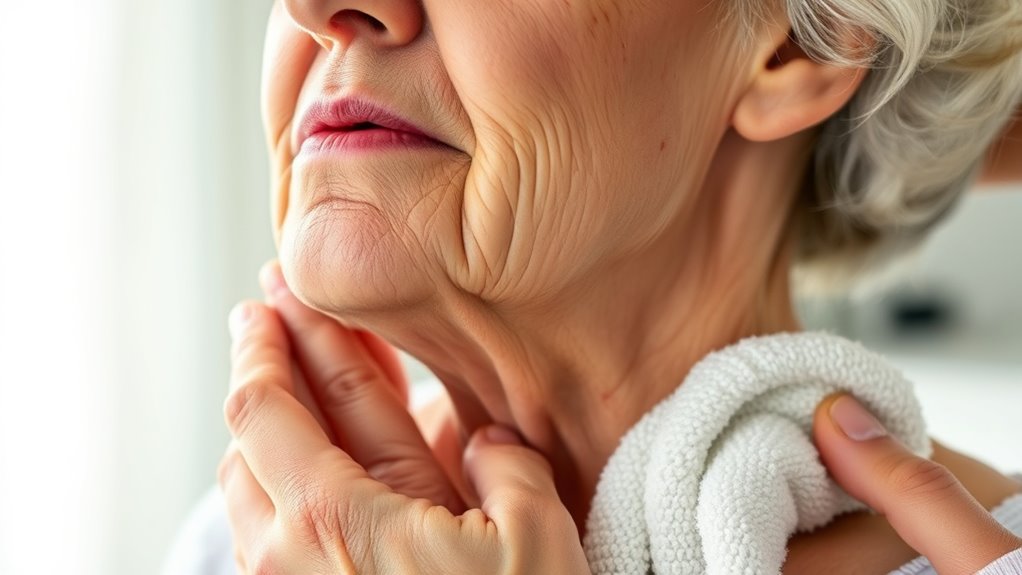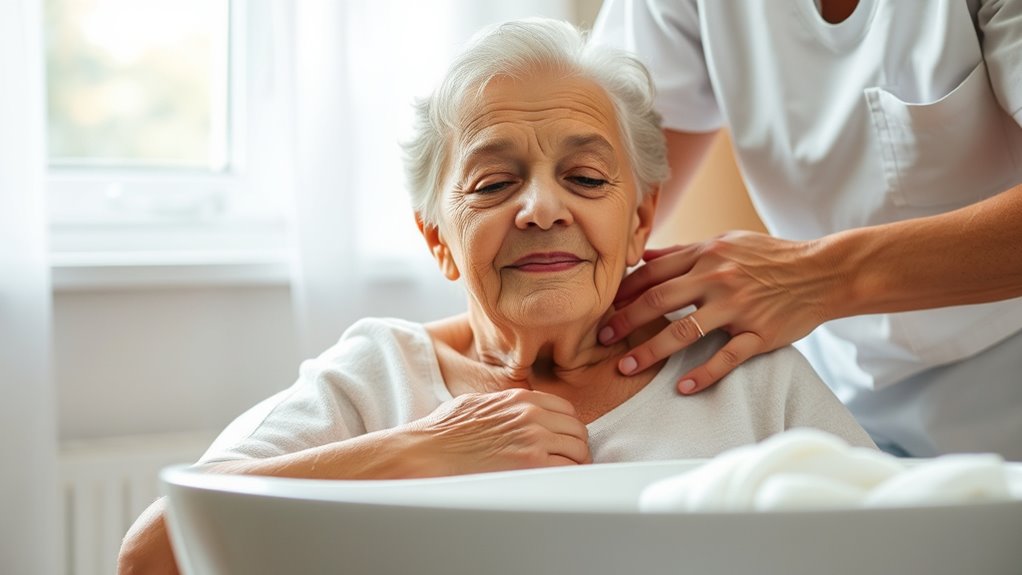To practice bed-bathing with dignity, start by preparing a safe, clean space and gather all supplies beforehand. Explain each step to the patient, maintaining privacy with covers and curtains, and use gentle, respectful communication. Begin with the face and neck, then wash arms, back, and lower body systematically, guaranteeing gentle handling. Focus on drying, moisturizing, and repositioning the patient to promote comfort and skin health. Continuing will reveal detailed techniques to ensure respectful, effective care.
Key Takeaways
- Prepare the environment, gather supplies, and position the patient comfortably to ensure safety and dignity.
- Communicate clearly, explain each step, and use privacy measures to respect the patient’s dignity throughout the process.
- Follow a systematic bathing sequence, starting with the face and progressing to other body parts with gentle, thorough cleaning.
- Handle sensitive areas gently, support the patient properly, and ensure water temperature safety to prevent injury.
- Dry thoroughly, moisturize skin, and reposition the patient regularly to promote comfort and prevent skin issues.
Preparing the Environment and Gathering Supplies

Before beginning the bed-bathing process, you should prepare the environment and gather all necessary supplies to guarantee a smooth and safe experience. Ensuring proper bed hygiene starts with a clean, clutter-free space that promotes comfort and minimizes infection risks. Gather supplies such as clean towels, washcloths, soap, basin, gloves, and any skin-care products needed. Position the bed at a comfortable height to prevent strain and maintain bathing safety. Keep a waterproof pad or sheet underneath the patient to protect bedding from moisture. Have a clean, warm cloth or towel ready for rinsing. Organizing everything beforehand helps you work efficiently, reduces stress, and creates a respectful environment for the patient. Proper preparation fosters a safe, hygienic, and dignified bed-bathing process. Recognizing the importance of infection control measures can further enhance safety during the procedure.
Explaining the Process to the Patient or Loved One

To guarantee the patient or loved one feels comfortable and informed, clearly explain each step of the bed-bathing process before you begin. This not only promotes dignity preservation but also provides patient reassurance, easing any anxiety. Let them know you will be gently clean their face, hands, and body, and ask if they have any preferences or concerns. Explain that you’ll be covering parts of their body with a towel to keep them warm and comfortable during the process. Use a calm, reassuring tone to emphasize your respect for their privacy and dignity throughout. Additionally, discussing bed-bathing techniques and their benefits can help prepare the patient for the procedure. By being transparent about what you’ll do, you foster trust and cooperation, making the experience more comfortable and respectful for everyone involved.
Ensuring Privacy and Maintaining Comfort

After explaining the process to the patient or loved one, it’s important to focus on guaranteeing their privacy and comfort throughout the bed-bathing. Cover them with a towel or sheet to maintain personal dignity, revealing only the area you’re cleaning. Be mindful of cultural considerations, respecting their traditions and preferences. Use a curtain or door to provide visual privacy, and speak softly to reassure them. Keep communication open, asking if they’re comfortable or need adjustments. Additionally, using proper hygiene practices helps prevent infections and promotes overall well-being during the procedure.
Starting With the Face and Neck

Starting with the face and neck is important to ensure you gently remove oils, dirt, and sweat that can cause irritation if left unattended. Face cleansing helps prevent skin infections and maintains skin health. Moving to the neck afterward is equally crucial, as this area often accumulates sweat and oils just like the face. Proper neck care involves gentle wiping to prevent skin irritation or discomfort. Starting with these areas sets a calm, clean tone for the rest of the bath, making the process more efficient. Use a soft cloth or sponge with warm water, and be gentle to protect sensitive skin. This approach respects the person’s dignity while ensuring thorough cleansing of the face and neck. Additionally, beginning with these areas can help promote better skin health and a more comfortable bathing experience.
Washing the Arms, Hands, and Underarms

Have you ever considered how thoroughly washing the arms, hands, and underarms helps prevent infections and odors? Proper arm hygiene involves gently scrubbing the entire surface, paying special attention to the elbows and underarms. Use warm water and mild soap to clean your hands thoroughly, including between the fingers and under the nails. For underarm care, lift the arm slightly and wash all around the area to remove sweat and bacteria. Rinse well to prevent soap residue, which can cause irritation. Make sure to dry the arms, hands, and underarms completely to reduce moisture that encourages bacterial growth. Regular, careful washing keeps these areas clean, reduces the risk of infections, and helps maintain fresh-smelling skin throughout the day. Incorporating a gentle deodorant or antiperspirant can further enhance underarm hygiene and control odor.
Cleansing the Chest and Abdomen

Properly cleansing the chest and abdomen is essential for maintaining overall skin health and preventing skin irritation. Use gentle motions with warm water and a mild, pH-balanced soap to minimize skin sensitivity. Be careful to avoid scrubbing too harshly, especially if the skin is fragile. Rinse thoroughly to remove soap residue, which can cause irritation or infection. Pat the skin dry with a soft towel rather than rubbing, to protect delicate skin.
- Use gentle, circular motions to clean
- Ensure thorough rinsing to prevent soap buildup
- Focus on drying completely to prevent moisture-related skin issues
Attending to the Back and Shoulders

After cleansing the chest and abdomen, shift your attention to the back and shoulders, which can be hard for individuals to reach on their own. Gently support the person’s back as you clean, using smooth, even strokes. Once the skin is clean, you can perform a light back massage to promote comfort and relaxation. Use gentle circular motions with your fingertips or palms, focusing on tense areas. Incorporate shoulder exercises if appropriate, like gentle lifts or rolls, to help loosen stiff muscles and improve circulation. Be attentive to their comfort and dignity throughout, maintaining a respectful and calm demeanor. This step not only ensures thorough hygiene but also provides a soothing experience that enhances their overall sense of well-being. Recognizing the importance of data privacy concerns, it is essential to handle personal information with care during caregiving activities.
Caring for the Lower Body and Legs

When caring for the lower body and legs, make certain the water temperature is comfortable and safe to avoid burns or discomfort. Use gentle, smooth motions to clean the skin, avoiding any harsh scrubbing. This careful approach helps protect sensitive skin and promotes a safe, soothing bath. Maintaining trust in caregiving is essential for ensuring the person feels safe and respected throughout the process.
Safe Water Temperature
Have you checked the water temperature before bathing the lower body and legs? Ensuring the water temperature is safe is essential for comfortable and safe bathing. Too hot water can cause burns or discomfort, while too cold water can lead to chills. Always test the water with your wrist or elbow before applying it to your patient’s skin. Aim for a warm, not hot, temperature—around 105°F (40°C). Keep the water at a comfortable level, and adjust as needed. Remember, maintaining safe bathing practices helps prevent skin injury and promotes relaxation. Using a thermometer or your wrist to test the water temperature is essential, and color temperature adjustments can help optimize the viewing conditions for comfort.
Gentle Skin Handling
To make certain the skin remains healthy and protected, handle the lower body and legs gently during bathing. Use soft, smooth motions to avoid skin irritation or injury. Pay close attention to skin hydration by gently rinsing and patting the skin dry, which helps prevent dryness and cracking. During bathing, perform regular skin inspection to identify any redness, sores, or other issues early. Be especially careful around bony prominences, where skin is more fragile. When washing, avoid excessive scrubbing or applying too much pressure. Gentle handling not only preserves skin integrity but also offers comfort and dignity. Remember, your careful touch helps maintain skin health and supports overall well-being during bed-bathing. Incorporating proper skin care practices can further help protect the skin from damage and support its natural healing processes.
Handling the Genital and Perineal Areas With Sensitivity

When cleaning the genital and perineal areas, use gentle techniques to avoid discomfort or injury. Respect the person’s privacy by covering them appropriately and speaking softly. Prioritize their comfort and always handle these sensitive areas with care and dignity. Incorporating gentle handling techniques can further ensure a respectful and comfortable experience.
Gentle Cleaning Techniques
Handling the genital and perineal areas with sensitivity is crucial for maintaining comfort and dignity during bed baths. Use gentle motions and warm water to clean these sensitive areas, ensuring you protect the skin’s hydration. Select mild hygiene products that won’t cause irritation, and avoid scrubbing. Focus on thorough but gentle cleaning to prevent infection while preserving comfort. Remember, a calm, respectful approach helps the person feel safe and respected. Keep the environment private and relaxed to promote trust. Always dry the area carefully to prevent moisture buildup, which can lead to skin issues. Your gentle touch and attention to detail ensure a respectful, hygienic experience.
- Use soft, clean cloths or sponges for cleaning
- Apply minimal hygiene products to reduce irritation
- Pat the skin dry to maintain hydration and prevent moisture buildup
Respect Privacy and Comfort
Maintaining the person’s privacy and comfort is essential when caring for the genital and perineal areas. You should always guarantee that the person’s dignity preservation is a priority by covering them with a blanket or towel, exposing only the area you’re cleaning. Speak softly and explain each step to help ease any discomfort. Be mindful of cultural considerations, respecting personal boundaries and preferences. Use gentle, slow movements to avoid causing pain or embarrassment. Maintain a professional and respectful attitude throughout the process, and always seek the person’s consent before proceeding. By handling these sensitive areas with care and sensitivity, you help preserve their dignity and promote a positive, respectful bathing experience.
Drying, Moisturizing, and Repositioning for Comfort

After completing the bed bath, it’s important to dry the skin thoroughly to prevent moisture buildup and skin irritation. Proper drying helps maintain skin hydration and strengthens moisture barriers, reducing the risk of infections. Use gentle patting motions instead of rubbing to avoid skin damage. Once dry, apply a moisturizer suited to the skin type to keep the skin soft and protected. Reposition the person frequently to prevent pressure sores and promote comfort. Adjust pillows and supports to keep limbs and joints in proper alignment. This not only enhances comfort but also encourages circulation. Remember, maintaining skin integrity and comfort is essential for overall well-being.
Dry skin thoroughly, apply moisturizer, and reposition regularly to prevent irritation and promote comfort.
- Use soft towels to pat dry, avoiding harsh rubbing
- Apply moisturizer evenly across all skin areas
- Reposition regularly for pressure relief and comfort
Frequently Asked Questions
How Can I Recognize Signs of Skin Irritation During Bed-Bathing?
When performing a skin assessment during bed-bathing, you should look for irritation indicators like redness, swelling, or warmth. Pay attention to any rashes, blisters, or broken skin, as these can signal irritation. If you notice these signs, stop the bath and document your findings. Recognizing irritation indicators early helps prevent complications and ensures your patient’s comfort and safety during the process.
What Are the Best Ways to Support a Patient With Limited Mobility?
Remember, “a little patience goes a long way.” To support a patient with limited mobility, use adaptive techniques like grab bars and cushioned supports. Communicate clearly with simple language and listen actively to their needs. Encourage independence when possible, and always respect their dignity. Your gentle, attentive approach helps boost their confidence and comfort, making their care experience more positive and empowering.
How Do I Handle Resistance or Discomfort From the Patient?
When a patient resists or feels discomfort, prioritize patient comfort and use communication strategies to ease their anxiety. Speak softly, explain each step clearly, and listen to their concerns. Respect their boundaries, and if they resist, pause and reassure them. Make adjustments as needed, and involve them in the process to foster trust. Your patience and empathetic approach help reduce resistance and promote a more comfortable, dignified experience.
What Techniques Ensure Dignity When Bathing Sensitive Areas?
To guarantee dignity when bathing sensitive areas, prioritize privacy preservation by closing curtains and covering the patient with a towel. Use respectful communication, explaining each step and asking for permission before touching sensitive areas. Maintain a gentle, calm tone and respect the patient’s comfort levels. This approach helps the patient feel safe and respected, promoting dignity throughout the process. Always listen and respond to their cues to enhance their sense of control.
How Often Should Bed-Bathing Be Performed for Optimal Hygiene?
You should perform bed-bathing according to frequency guidelines that meet hygiene standards and the individual’s needs. Generally, daily baths or at least every other day help prevent infections and maintain cleanliness. However, if your patient has specific skin conditions or limited mobility, more frequent baths may be necessary. Always monitor for signs of discomfort or skin issues, and adjust the schedule to ensure ideal hygiene and comfort.
Conclusion
By following these respectful, step-by-step techniques, you guarantee your loved one’s dignity and comfort during bed-bathing. Some might worry it’s time-consuming, but the gentle, thorough approach fosters trust and promotes hygiene. Remember, taking the extra moment to handle each area with care not only keeps them clean but also reinforces their sense of safety and respect. With patience and empathy, you make this routine a meaningful act of compassion.









